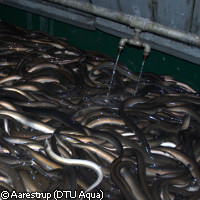Researchers unlock mystery of European eel's spawning migration
Tracking the movements of individual fish in oceans is not easy, but an international group of scientists has done just that. The research results, published in the journal Science, show how the scientists successfully followed a group of European eels during the first 1,300 km of a 5,000 km journey. The research is part of the EELIAD ('European eels in the Atlantic: assessment of their decline') project, supported under the 'Environment' Theme of the EU's Seventh Framework Programme (FP7). Due to end in 2012, EELIAD has received over EUR 2.6 million in financial support. The researchers from Canada, Denmark, Ireland, Norway, the UK and the US assessed the European eels (Anguilla anguilla) that embarked on their annual mating ritual. Swimming from the coast of Ireland to the Sargasso Sea, which is located near Bermuda in the middle of the North Atlantic Ocean, some of the eels were tagged with miniaturised satellite transmitters - called pop-up satellite archival tags (PSATs) - so as to help the researchers map the first part of their trip. The information gathered in this study gives insight into the swimming direction and depth, and migratory behaviour of these eels. The results also offer a glimpse into the various environmental surroundings the eels travel through during their journey. Coordinated by Professor David Righton of the Centre for Environment Fisheries and Aquaculture Science (Cefas) in the UK, the study's researchers found that the eels stayed in warm surface water (at a depth of between 200 to 300 metres) during the night, but dived down into cooler waters at a depth of up to 1,000 metres and stayed there during the day. According to the researchers, the warm water at night seemingly supports the eels' efforts to keep up their metabolism and swimming activity. The findings also suggest that the cooler daytime water may keep the development of the eel's reproductive organs in check. In other words, their reproductive organs are developed when they reach the warm, tropical waters of the Sargasso Sea and finally mate. 'This is entirely new knowledge and we can only speculate on why eels do this. We hypothesise that the observed pattern may reflect thermoregulation,' explained Professor Righton, who co-authored the study. 'Eels may move into warm water at night to maintain sufficiently high metabolic rates and swimming speeds and then descend into deeper and colder waters to delay the maturation of their gonads. This would mean that they maintain their hydrodynamic profile for most of their long migration, rather than becoming bloated with eggs which would then increase the energy needed to swim.' Said lead author Dr Kim Aarestrup, a senior scientist at the National Institute of Aquatic Resources at the Technical University of Denmark (DTU Aqua): 'This is a brilliant result in many different ways. Eels are difficult to follow once they leave European shores, so their behaviour as they migrate to their spawning grounds is almost a complete mystery.' Dr Aarestrup, who also led the tagging work in the EELIAD project, went on to say: 'The study has added to the understanding of the migration and surprised the scientists in several ways.' The European eels spend their early years in rivers before heading out to sea and across the Atlantic Ocean to the Sargasso Sea. They spawn and lay eggs, which hatch into transparent larvae called leptocephali, and set out on a return journey to Europe by floating on oceanic currents. Once they arrive, they will have already developed into little glass eels that swim into Europe's rivers. The researchers noted that improvements to the satellite tracking technology in the future would help them track this spawning migration process in its entirety.



